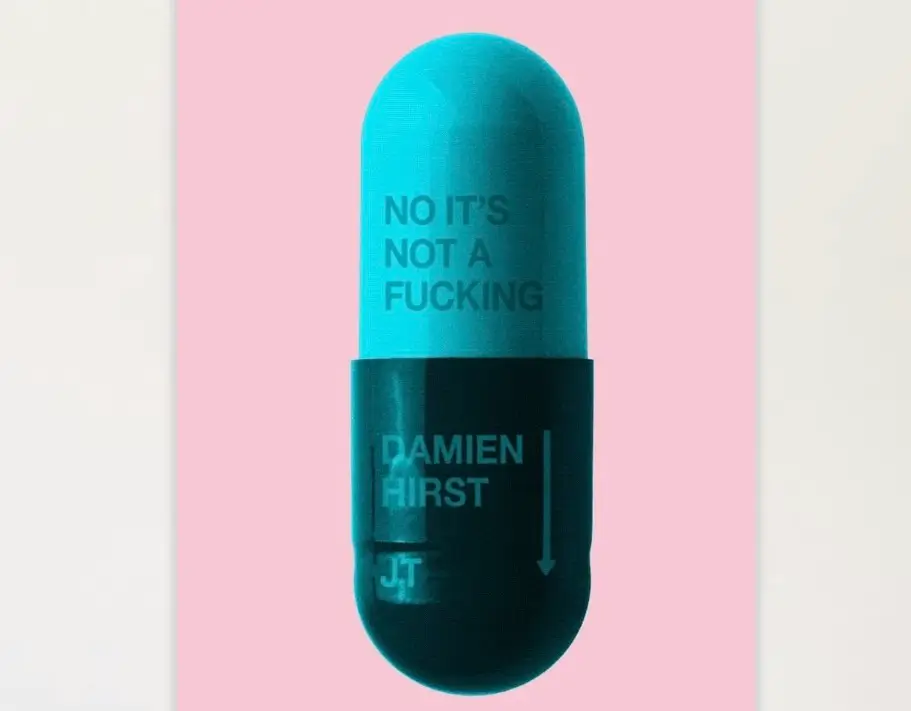In Musashi (2024), Cryptik continues his long-standing devotion to unifying ancient wisdom with contemporary aesthetics—an approach that has become his artistic signature across murals, prints, and meditative calligraphic installations. This giclée print, produced on heavyweight 330gsm archival cotton rag and finished with deckled edges, occupies a space between the transient and the enduring. Its materiality evokes the traditions of fine-art printmaking, while its formal language expresses something far older: the disciplined, unshakeable clarity of Eastern philosophical thought.
The print’s surface is defined by a tightly arranged constellation of calligraphic glyphs—forms that suggest an alphabet yet remain deliberately unreadable. Their structure echoes Blackletter, Sanskrit curves, Arabic ornamentation, and Japanese brush forms without ever resolving into a fixed linguistic system. Cryptik has long used this hybrid “script-like form” to transcend linguistic boundaries. Rather than communicating through literal text, his symbols communicate through rhythm, symmetry, and the meditative act of mark-making itself.
dialogue
The work is titled Musashi, referring directly to Miyamoto Musashi—the legendary 17th-century swordsman, philosopher, artist, and author of The Book of Five Rings. Musashi’s teachings extend far beyond martial practice; they touch on strategy, self-mastery, impermanence, and the union of form and emptiness. His voice has influenced warriors, entrepreneurs, monks, artists, and designers alike.
Cryptik’s visual language resonates deeply with Musashi’s philosophy. The glyphs—structured yet fluid, forceful yet patient—reflect the duality Musashi mastered throughout his life. They feel like the disciplined strokes of someone who understands that every gesture carries intention. The density of the grid reinforces Musashi’s belief in repetition: the endless refinement of action until skill becomes subconscious, almost spiritual.
This balance between rigor and surrender is central to Cryptik’s practice. His compositions emerge from hours-long meditative writing sessions, where repetition becomes a ritual. In Musashi, that ritual crystallizes into a matrix of glyphs that appear to vibrate, shifting between abstraction and proto-language as the viewer’s gaze moves. It evokes a page torn from a sacred manual—something that records nothing and teaches everything.
material
The decision to produce the work as a giclée print on 330gsm cotton rag is not incidental. Heavy cotton rag is prized for its tactile softness and extraordinary ability to hold fine detail; it echoes the tradition of parchment, scroll-making, and handmade paper. The print’s deckled edges—intentionally roughened and feathered—add a subtle ritualistic quality, as though the work were a surviving fragment of a lost manuscript or a hand-cut devotional object.
Cryptik’s contrast between the precision of the glyphs and the irregularity of the edges produces a compelling tension. The interior of the composition is tightly controlled; the outer borders are organic, almost vulnerable. This material contradiction mirrors Musashi’s own teachings: form must be disciplined, yet one must remain flexible; mastery requires both sharpness and surrender.
The monochromatic palette amplifies this dynamic. Against the dark ground, the calligraphic shapes glow as though illuminated from within. Their arrangement suggests the logic of mandalas—geometric diagrams used as tools for meditation—yet they resist perfect symmetry. Instead, they pulse with the subtleties of the artist’s hand: slight shifts in proportion, micro-variations in stroke weight, small disruptions in pattern. These imperfections do not detract; they animate. They remind the viewer that enlightenment is a practice, not a product.
flow
For more than a decade, Cryptik has created what many refer to as the Cryptik Codex—a universe of symbolic writing that forms the backbone of his visual practice. It is at once a personal script, a spiritual diagram, and an invented language with no direct translation. The work’s strength lies precisely in this refusal to resolve into meaning. Like sacred geometry or Islamic calligraphy, Cryptik’s script generates a contemplative environment rather than a message.
Musashi extends this codex through a structure that echoes the austerity of Zen monasteries and the silence of solitary training halls. The grid becomes a dojo: a space of repetition, discipline, and inner stillness. Each glyph becomes a strike—a single action performed with total presence. Viewed this way, the print documents not a text but a state of being.
Cryptik often incorporates philosophical excerpts into his large-scale murals, and although Musashi does not include literal quotations, its energy reflects Musashi’s most well-known assertion:
“Do nothing which is of no use.”
This principle becomes visible in the unwavering intentionality of each mark. There is no excess. No embellishment. No ornament for ornament’s sake. Even the swirling flourishes—echoes of Gothic calligraphy—serve a structural rather than decorative purpose.
culture
Cryptik’s oeuvre has always operated at the intersection of cultures—bridging East and West, tradition and street practice, the sacred and the contemporary. Musashi encapsulates this synthesis. The calligraphy feels medieval and futuristic, global yet deeply personal. It refuses to sit within a single lineage, embodying instead the interconnected nature of spiritual philosophies.
The print also gestures toward the aesthetics of turntable culture and street art—the same subcultures that Cryptik emerged from. There is an urban pulse beneath the contemplative surface. The repetition recalls tagging; the tight composition evokes the stacked density of handstyles on a wall. Yet unlike graffiti, the intention is inward. The work speaks not to public space but to inner space.
In this sense, Musashi represents the convergence of two worlds: the street and the temple. It brings the contemplative rigor of Zen into the visual language of contemporary subculture, reframing ancient ideas through a modern calligraphic system.
impression
Displayed in a living room, studio, or gallery, Musashi operates not as décor but as a presence. Its glyphs invite slow looking, prolonged engagement, and repetition—mirroring the very process that created them. The more time one spends with the print, the more its rhythms emerge. The dense arrangement becomes less rigid and more fluid. Patterns dissolve, reassemble, and release. What first appears unreadable becomes a kind of visual koan: a puzzle whose purpose is not solution, but awakening.
Like Musashi’s teachings, the work rewards patience. It does not offer answers, but reveals the beauty of inquiry itself.
No comments yet.








